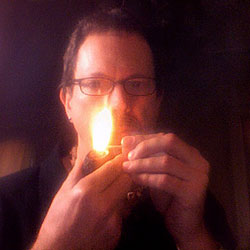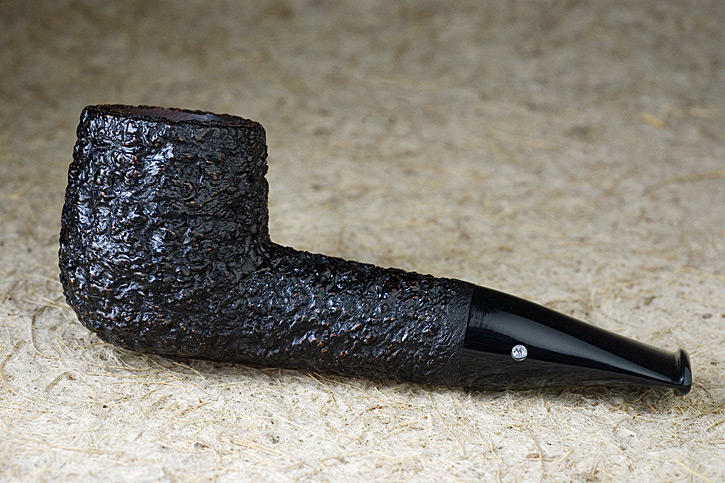G. L. Pease
 I’ve been saving the ash from my smokes for a couple weeks, partially in response to some vocal claims made by a few that smoking to the bottom is either nearly impossible, or that doing so almost guarantees destruction of the pipe through burnout.
I’ve been saving the ash from my smokes for a couple weeks, partially in response to some vocal claims made by a few that smoking to the bottom is either nearly impossible, or that doing so almost guarantees destruction of the pipe through burnout.
Truth is, I’m actually pretty far away from what anyone would consider an “expert” at smoking a pipe. I’ve somehow stumbled my way to a passable technique over the years, and I enjoy my smokes as much as anyone can, but thrown into the gladiatorial pit of a smoking contest, I’m always one of the first guys to find himself missing limbs, and the idea of sitting down with a pipe minus a full lighter and/or a box of matches immediately at hand fills me with terror.
I tend to fill my pipes haphazardly, paying little (okay, practically zero) attention to the whole “hand of a child, hand of a woman, hand of a man” packing strategy that we read about in every pipe smoker’s primer, yet still, somehow, I’ve always managed to smoke to the bottom of the bowl almost every time, at the end, depositing nothing but the fabled “dry grey ash” in the tray. (Skeptical? There are witnesses. My legendary smoking prowess has been sung about by bards, and written about on forums, and if it’s on the internet, you know it’s true.) So far, it doesn’t appear that I’m doing any damage to my beloved briars, but it’s only been 33 years, so it’s still possible that one day, as reward for my continued abuses, one of my bowls will detach itself from the shank, and fall into my lap, a smouldering, cackling mass of malevolent ember and soot.
More seriously, I know I’m far from the only one who accomplishes this amazing feat, and, I’d be the first to say that, at least in my case, it is completely accidental, and arguably, absolutely irrelevant.
Not everyone cares about smoking to the bottom, and doing so or not doesn’t seem to have any relationship to the level of enjoyment a piper gets from the experience. I knew a veteran pipeman, a collector of some merit who had forgotten more about pipes, smoking pipes, collecting pipes than most of us will likely ever know, who was particularly fond of very old Three Nuns tobacco. He’d managed to acquire quite a supply, and bought more whenever he found it, thus being assured of always having some of these precious coins in his treasure chest.
He also only enjoyed smoking the first half of a bowl. Seriously. He simply didn’t like the taste that developed in the bottom half, so he didn’t smoke his pipes much past the half-way point, no matter how many people told him he’d “ruin his pipes that way.” He was also a fiscally sensible fellow, and not wanting to waste his precious vintage weeds, he’d buy tins of the contemporary version, filling the bottom of his pipe with that, then toping it off with the old stuff and puff away, surrounding himself with fragrant, billowing clouds of unquestionable contentment. He enjoyed his pipes as much or more than anyone I’ve ever met, so who’s going to queue up to criticize his methodology? His pipes, by the way, didn’t seem to explode from his mistreatment, either.
The pipe world is filled with all sorts of “conventional wisdom,” little demi-truths that, through endless repetition, either become embedded in the collective consciousness, or are dismissed as absurdities. Another of those concerns breaking in a new pipe.
Many pipemen look forward to breaking in a new pipe with as much enthusiasm as they might a root canal. Historically, there may be some basis for the dread. At a time when most pipes were turned out of factories by the thousands, or even millions, in some cases, paying attention to each block of briar, the way the burl was handled after being dug out of the ground, cut into bits, boiled, dried and delivered, was impractical, if not impossible. Some luxury-pipe producers developed special seasoning techniques, of course, such as Dunhill’s famed oil-curing, but high-volume, mass-market pipes, produced at a time when a significant percentage of adult males smoked pipes, were commodity items, made to be sold as inexpensively as possible. At those production levels, maintaining a several year supply of aging wood would have been economically unfeasible. Briar was bought, stored briefly, and fashioned into pipes that were then packaged and sold, leaving the consumer with the sometimes bitter chore of curing and seasoning their new acquisition. Most pipe smokers took it on the chin, accepting this as a normal part of the “break-in” process. But, today, with fewer pipe smokers resulting in lower overall market demand, the fiscal pressures are different, and we can almost take for granted that our new pipes will be carefully crafted from briar that’s been more skillfully and deliberately treated from soil to stummel. The dread, though, seems to persist in the minds of many.
Though it’s still, and will always be true that the early bowls in a new pipe are never going to be the best that the pipe will deliver, I actually enjoy the process. I like the taste of the briar, the experience of gradually developing a cake, the way the pipe’s flavour and richness continue to develop with every fill, the way the patina of the wood’s surface develops over time. It’s a wonderful “getting to know it” process that I look forward to whenever I have the good fortune of finding myself with a sparkling new pipe. Going back to the realm of “conventional wisdom,” however, I’ve never subscribed to what I’ll call the “By Thirds” method of breaking a new pipe in.
We’ve read a thousand and one times that the best way to start a new pipe off on its journey is to fill it either 1/3 or 1/4 full for the first dozen bowls or so, smoking carefully, slowly, and only then, gradually increasing the level of tobacco in the pipe by quarters or thirds until, finally, after many bowls, the pipe can be filled to the top and enjoyed to its fullest. It’s always seemed a bit fiddly. In fact, more than one of my early mentors told me, unequivocally, that it was best to ignore this unnecessary nonsense. “Just fill it, smoke it slowly, and enjoy it.” And, so I have. Until recently.
Several weeks ago, a good friend, knowing that I have a strange fondness for the little things, gave me a beautiful Castello Sea Rock #10, the abbreviated brucianaso shape that I’ve championed for a few years, and that he’d never smoked. One evening, with my typical enthusiasm, I sat down to begin the process of breaking it in, of making it my pipe. Somewhere along the way, dedication to my usual method took its leave, and a wind of wyrd blew through the lair, compelling me to try the “By Thirds” method.
At first, it felt awkward, strange, foreign. Even when I only want to smoke half a bowl, like my old collector friend, I’ll smoke the top half. Pipes just never seem to perform their best for me with less than an at least mostly-full bowl. (We can speculate all day about why this might be the case, or even if it has any real merit at all, but it’s been one of my little personal demi-truths that has persisted throughout my pipe smoking life, and attempts to disprove it have always left me with less than satisfying results.) But, I persisted. Over the first few days, I smoked ten short fills, paying close attention to what was going on.
The first few mini-bowls smoked, expectedly, like they would in a new pipe. The taste of the wood was in focus, the characteristic brightness that seems to be something of a trademark of Castellos (and the pipes from some other marques, as well) presented itself as it always does, and, equally predictable, there wasn’t a lot of richness in the smoke, but the only thing really unsatisfying in the overall experience was that the smoke was finished long before I was. It took discipline to persist, but I was committed to the process.
When it was time to progress to the second phase, the 2/3 fill, something interesting was happening. The cake the pipe was developing was beautiful, if that adjective can be rightfully applied to what is essentially little more than a thin layer of carbon molecularly bonded to the briar’s surface. It was smooth, even, and finely, tightly crystalline, not at all coarse or spongy. The wood in the chamber had darkened noticeably, offering a smooth gradient from all but virginal and pure to very dark chestnut, and then cake and ash. And, more importantly, the pipe was starting to taste remarkably good. Even without the evolution that takes place during a long, full smoke, it was offering a deeper smoke than I expected so early in the process.
Today, my new little pipa corta and I have progressed to the third phase, and things continue to get better. I’m almost a believer, almost willing to admit something of an epiphany here. As much as I’ve scoffed at something I’d always considered overly fussy, I think I might be changing my mind. Of course, it’s only one pipe; maybe it’s one of the special ones, an outlier. It’s only a single data point, and one point don’t make no line. I need to repeat the experiment a few more times, and I will as the opportunity presents. But, for now, I’m willing to suspend disbelief and accept that, just maybe, there’s some truth rooted in the ground of this bit of ancient lore, and somehow, that seems comforting.
Your turn.
-glp
Castello Pipe and Ashes Photos Credit & Copyright © 2013 G. L. Pease. Used by Permission
 Since 1999, Gregory L. Pease has been the principal alchemist behind the blends of G.L. Pease Artisanal Tobaccos. He’s been a passionate pipeman since his university days, having cut his pipe teeth at the now extinct Drucquer & Sons Tobacconist in Berkeley, California. Greg is also author of The Briar & Leaf Chronicles, a photographer, recovering computer scientist, sometimes chef, and creator of The Epicure’s Asylum. See our interview with G. L. Pease here. |






















Great article Greg, thanks. I always smoked to the bottom of the bowl because the flavors keep getting better and better. At least a couple of times a week I will suck in hot ash trying to get the last bit of flavor even though I have been at this for quite some time, you would think I would learn not to be so greedy but when it comes to flavor, I don’t give it up without a fight. I have never burned out a pipe or even come close to it. I see no reason not to continue smoking it to the bottom until there is nothing left. Now if for some reason the flavors were not getting better I would dump it and start a fresh bowl. Maybe it is the type of tobacco I smoke ( Va and Vaper flakes only) but they get stronger and more intense the lower I go.
In regards to breaking in a new pipe, I have always filled it to the top and smoked it to the bottom with no issues. My pipes have always built a nice even cake this way and I do not smoke any differently than I would with a broken in pipe. I enjoy breaking in a new pipe with an un-coated bowl because of the flavor of the briar in the first few bowls. I have heard about the 1/3, 2/3 method since I began smoking a pipe in 2000 but never did it myself, it just does not make sense to me. I get a nice even cake from the top to the bottom using my method and see no reason to change after all these years. My mind views it that if I am only smoking it in thirds, then the cake will not be uniform. I know plenty of people do it this way but I have always subscribed to the theory if it ain’t broke, don’t fix it.
I use the Mr. Gumby method of bowl filling “get some tobacco and put it – in your pipe”!
I’ve never bothered with the third bowls break-in either but it seems from your experience that, rather than being a heel cake building requirement, it is a method of applying dry heat (rather than fire) to the upper chamber walls with a good effect on thin calikg and perhaps further drying and curing?
I wonder if the Dunhill (Ashton) oil curing depended more on the resting on heated metal pegs than on the “beneficial oils”?
To me, the smoking in thirds or half bowls make sense, because I do not smoke to the bottom of the bowl all that often. I get distracted a lot and must attend to other things, and the pipe goes out, and relights don’t taste as good halfway down, or the flavor will deepen to a degree I don’t much care for, etc. Whatever the reason I find myself really not willing to smoke all the way to the bottom. But I would still like some cake down there to help with moisture and overall smoking quality of the pipe. So even now I frequently only smoke half bowls so I can facilitate cake at the bottom. But if each briar pipe will smoke differently… I wish you the best of luck in finding an answer. There may not ever be a truly clear and 100% agreed upon answer in this hobby. So fun.
Thank you for the article. Enjoyed the read very much.
+1 on the fine article. I tried to break in a couple of pipes that way, but inevitably I am impatient, so after being unsatisfied with the first third, just stuff and go afterwards. In the hundred or so pipes I have smoked and owned, I have never, ever, had a burnout. Some blends are better smoked in the first half, some do not come alive till the second half. Frugality prevents me from just smoking half a bowl, anyway. Heck, even taking notes, I cannot remember which tobaccos are better which way, and just when I think I have a system, along comes another tobacco blend that messes up that idea. So, IMHO, smoke it all, all the time, and everyone needs to do their own thing. Life is too short for rules anyway.
I really appreciate the time and effort you invest in these articles. Good writing and superb photography every time.
.
I’m surprised by your success with the “by thirds” method, seeing as you neglected to mention that each stage commences on the appearance of the full moon; or, perish the thought, you’re intentionally keeping that ace up your sleeve. And, I suspect, you’re intentionally keeping the secret ritual incantations to yourself too!
.
Russ Ouellette’s practical approach to the break-in process has a certain homely appeal for me: if you never smoke a bowl down to the bottom, there’s no need build a cake of carbon there. So don’t worry, be happy 🙂
The best thing about this ongoing experiment is that you’ll need a steady stream of new pipes in your quest for more reference points! 🙂
Jimbo wrote:
.
You might be onto something, Jim. The first part of the “breaking in” is likely a variation of heat-hardening, where combustible volatiles and water are driven off, and the structure of the surface wood tightens and hardens. As long as this happens without charring, it’s a good thing. If the temperature of the copper pegs was high enough, some amount of annealing may have taken place. I’ll talk with a friend of mine who has a lot of experience in this department, and see if he can shed some light.
.
Thanks to all for the comments so far. Interesting stuff! I’ll keep trying the new/old method, and yes, it does provide an excuse for more pipes. As though I need either an excuse OR more pipes…
.
(And, thanks for the . tip for separating the paragraphs. One of these days, I’ll dive into the CSS and fix that…)
.
-glp
That is a wonderful article, and like cortezattic, I, too, appreciate your excellent pipe prose.
I have tried the gradual approach to breaking in a new pipe. Somehow, I may have missed something important. It just didn’t seem to matter that much as time went by.
I tried the baby steps with a couple of new pipes, especially a couple of Dunhills and Ashtons when first purchased. They were my new babies, see, requiring special care and attention.
But in the end, I figured, as in most things, I was doing something wrong. It just didn’t seem to work for me. After that, I filled my pipes and got on with it.
But, it is always a pleasure to read glp. I learn something every time.
Real nice article. Well thought out.
I will still continue on in my normal way, though. I have no problem smoking to the bottom of the bowl even though I am a bit of a puffer. And I am way too impatient to go through an involved and lengthy break in process. I only buy two or three new pipes a year anywya.
What is the primary purpose for the thirds method? If you always smoke your tobacco all the way to the bottom (which I do 97% of the time), why bother with the thirds?
Thanks for another great article and replies.
Like tennsmoker I tried the part filling break in method with several Dunhills; in my case because they recommended it on the leaflet that came with the pipe and because my first Dunhill seemed such a thumping great investment I did not dare risk doing otherwise. I think they recommended starting with halves and after a few pipes starting to work up to a full load. As this was linked with a warning against smoking hot generally and particularly doing so outside in the wind during breaking in I assumed the partial load was supposed to stop the pipe from smoking too hot before it built up a cake. I abandoned the practice because I found that smoking a part fill made it harder not easier to avoid over heating, even in a well broken pipe when I wanted a short smoke, so it seemed counter productive as well as a bit fiddly. I also vaguely recollect that Dunhill’s advice changed with the years to something like “although nowadays pipes are ready to smoke you may wish to ….” so perhaps even in the last thirty years the Dunhill briar processing method changed.
Certainly some old time pipe smokers believed in dry heat to break a pipe in – they used a hot poker. My generation were strongly warned against that practice in the literature and, envisaging a red hot poker, I sagely shook my head at such folly. But what if it was many applications of a fairly hot poker on not very well (perhaps not at all) seasoned briar perhaps, following Jimbo and Greg’s logic, they had a point and this was a good method for those times.
Well I happen to have a new pipe to break in, a much more modest Italian than Greg (a chunky Luciano with a saddle bit) and will it be the hot poker? Sadly, I no longer have a poker but I just may try the thirds method; after all Greg’s articles have converted me to matches rather than a lighter and, even after all these years, it is fun to experiment and learn.
I always smoke to the bottom of the bowl, however I have noticed it is easier to do so with higher end pipes as opposed to my inexpensive pipes. The only conclusion I can come to is that it may have something to do with the age and quality of the briar. I even go so far as to occaisionally getting a sizzling noise, but I soldier on like an obsession. I have noticed that with my lower end pipes, it can be a bit of a chore, but it has always been worth the hassle.
+1 this article is very good
Before I tried the baby steps with a couple of very good pipes, especially a couple of Dunhills
You will make a fine and proper old man, some day. Even with your obvious genius for mixing and love of pipes.Glad I know you, your wittiness, and your love of life. Well, as well as I can, through a can.
With a new pipe, I just fill it to the brim, tamp it and light up.